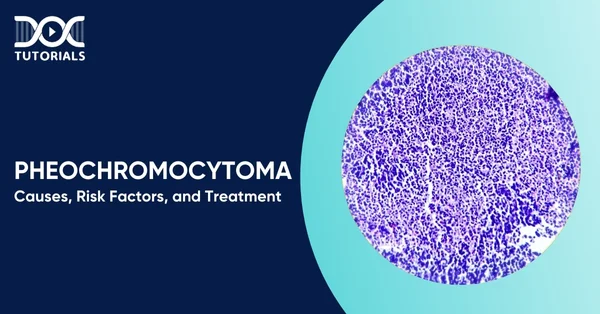Pheochromocytoma | Causes, Risk Factors, and Treatment

Pheochromocytoma originates from the adrenal medulla’s chromaffin cells. It is a rare neuroendocrine tumour that produces catecholamine. As per the classification of the World Health Organisation (WHO) for endocrine tumours, pheochromocytoma cases can be metastatic (cancer that spreads from its original location to other parts of the body).
If you are a NEET PG student, getting a detailed insight into this topic is necessary. So, keep reading to learn about the causes, symptoms, risk factors, and treatment procedures of pheochromocytoma.
What is Pheochromocytoma?
A pheochromocytoma is a tumour formed in the middle of an individual’s adrenal glands. It can develop in one or both glands and contains chromaffin cells. These cells are known for producing and releasing hormones responsible for the “fight or flight” response.
Pheochromocytoma can cause more than one tumour in the affected person’s adrenal gland, which is non-cancerous or benign in most cases. However, 10%-15% of the tumours can be malignant or cancerous.
What are the Causes of Pheochromocytoma?
The exact cause of pheochromocytoma is still not known to doctors. It can occur randomly or due to genetic issues. As per the National Organisation for Rare Diseases, 25%-35% of pheochromocytoma cases are inherited.
Though pheochromocytoma can occur at any age, the most affected individuals belong to the age group of 20 – 50 years. If a person gets pheochromocytoma genetically, they may also develop the following conditions:
- Neurofibromatosis type 1 (NF1)
- Von Hippel–Lindau (VHL) syndrome
- Sturge–Weber syndrome
- Multiple Endocrine Neoplasia type 2 (MEN2)
The following conditions can also act as risk factors for pheochromocytoma:
- Body strain during childbirth or hard physical activity
- Individuals who need anaesthesia due to surgery or a similar procedure
- Extreme physical or emotional stress
- Tyramine, a component found in aged or fermented foods like chocolate, wine, and cheese, can also trigger the condition.
Certain medications may also cause pheochromocytoma symptoms in some individuals. Monoamine oxidase inhibitors, for instance, which are used to treat depression and other mental health issues, have been known to have side effects that can result in symptoms.
What are the Symptoms of Pheochromocytoma?
Common symptoms of pheochromocytoma include the following:
- Headache
- Rapid heartbeat
- High blood pressure
- Excessive sweating
- Shaking nervously
- Pallor or skin turning to a lighter colour
- Anxiety
- Shortness of breath
- A sudden, intense fear, like the symptoms of a panic attack
- Weight loss
- Vision problems
- Constipation
Some individuals may not have symptoms of pheochromocytoma. Only an imaging test helps detect the tumour in those people.
How to Diagnose Pheochromocytoma?
The following diagnostic methods help detect pheochromocytoma:
- Blood and Urine Tests
These tests are used to measure the levels of specific hormones in your body, which can indicate the presence of pheochromocytoma. Additionally, genetic testing might be performed to identify any inherited conditions that could increase your risk.
- CT Scan
A CT (computed tomography) scan uses X-rays combined with computer technology to create detailed, three-dimensional images of your body. This helps doctors locate and assess the size of any tumours.
- MRI
Strong magnets, radio waves, and a computer are used in magnetic resonance imaging (MRI) to create finely detailed three-dimensional images of your inside organs and structures. This test helps visualise soft tissues and identify tumours.
- Radioisotope Scan
This test introduces a small amount of radioactive material into your body. Tissues that produce excess epinephrine absorb the substance, making it possible to see the tumour during the scan. Areas that take up the radioactive material appear clearly on the resulting images, helping pinpoint the tumour’s location.
What are the Treatment Options for Pheochromocytoma?
The following are the treatment methods for pheochromocytoma:
- Preoperative Medical Management
Before surgery, patients are given medications to control blood pressure and minimise the risk of dangerous spikes during the procedure. Alpha-blockers, beta-blockers, and calcium channel blockers are commonly used to relax blood vessels and slow the heart rate, improving blood flow and stabilising blood pressure.
A high-sodium diet is often recommended to increase blood volume and prevent low blood pressure after these medications.
- Surgical Removal (Adrenalectomy)
Surgery is the primary treatment for pheochromocytoma. Most tumours are removed using minimally invasive techniques, such as laparoscopic or robotic adrenalectomy, which involve small incisions and specialised instruments. The preferred approach is often the Mini Back Scope Adrenalectomy (MBSA) for most patients, offering quicker recovery and less postoperative pain.
For larger or invasive tumours, open surgery with a larger incision may be necessary. The surgeon may remove the entire adrenal gland or, in select cases, only the tumour to preserve adrenal function, especially if the other gland has already been removed.
- Management of Metastatic Disease
Suppose the tumour has spread beyond the adrenal gland (metastatic pheochromocytoma). In that case, surgery may be used to remove as much tumour tissue as possible to ease symptoms and help control blood pressure. However, complete removal is often not feasible, and additional therapies are required.
- Additional Cancer Treatments
For malignant or metastatic cases, several treatments may be considered:
- Targeted Therapy: Uses drugs that specifically attack cancer cells, sometimes combined with radioactive substances to kill tumour cells.
- Chemotherapy: Employs powerful medications to destroy rapidly dividing cancer cells, helping control symptoms and tumour growth.
- Radiation Therapy: Delivers focused energy beams to shrink or destroy tumours, especially those causing pain in the bones.
- Ablation: Destroys tumours using extreme temperatures or substances like ethanol alcohol, targeting cancerous tissue with minimal invasion.
- Postoperative and Lifelong Management
Following surgery, routine monitoring is necessary to check for recurrence. If both adrenal glands are removed, lifelong steroid hormone replacement therapy is necessary to compensate for lost adrenal function. Ongoing blood tests and checkups ensure early detection of any returning disease.
FAQs About Pheochromocytoma
- How to prevent pheochromocytoma?
Pheochromocytoma cannot be prevented, but people with a family medical history or genetic conditions like MEN2, VHL, NF1, Carney-Stratakis dyad, or Carney triad should consider genetic testing.
- What is the prognosis for pheochromocytoma?
If both adrenal glands are removed, you’ll need lifelong hormone replacement medication. Regular doctor visits are essential to monitor for recurrence and manage side effects. Survival rates are high if the cancer hasn’t spread.
- How can you manage the symptoms of pheochromocytoma?
Pheochromocytoma symptoms, like high blood pressure, headaches, palpitations, and sweating, can be intermittent. Alpha-blockers and beta-blockers help control blood pressure, heart rate, and hormone-related symptoms.
Conclusion
Pheochromocytoma is a tumour that develops in the adrenal glands. It leads to excessive hormone production and potentially dangerous spikes in blood pressure. Proper diagnosis and the right treatment can help control the condition.
Are you an NEET PG aspirant seeking complete guidance on topics like pheochromocytoma? Join DocTutorials. Our specialised video lectures, one-to-one online classes, and mock tests guide you through the NEET PG journey. Check out our NEET PG courses today!
Latest Blogs
-

NEET SS Exam 2024: Analysis, Key Dates, Counselling
The NEET SS 2024 exam kicked off on March 29, 2025. Over two days and two slots, candidates across 13…
-

NEET PG Registration 2025: An Essential Guide For Exam Prep
The NEET PG registration, which is conducted online, is a crucial step in the exam process. Filling out the NEET…
-

NEET PG Syllabus 2025: A Must-Have Complete Guide for Exam Success
The NEET PG Syllabus acts as one of the foundation stones for aspiring postgraduate medical students like you who are…




